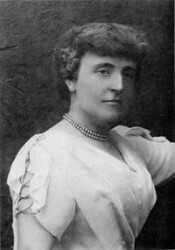Burnett Frances Hodgson

Frances Hodgson Burnett (November 24, 1849 – October 29, 1924) was an Anglo-American playwright and author. She is best known for her children's stories, in particular The Secret Garden, A Little Princess, and Little Lord Fauntleroy. She was born Frances Eliza Hodgson in Cheetham Hill, Manchester, England. Her father died in 1854, leaving her mother to support five children. They had to endure poverty and squalor in the Victorian slums of Manchester. In 1865 she emigrated to Knoxville, Tennessee in the United States. The move, which the family made at the request of an uncle, did not alleviate their poverty, but they were now living in a better environment. She lived in a house in New Market, northeast of Knoxville off of 11E; in front of the house there is a sign which contains details. Following the death of her mother in 1867, the 18-year-old Frances was now the head of a family of two younger siblings. She turned to writing to support them all, with a first story published in Godey's Lady's Book in 1868. Soon after she was being published regularly in Godey's, Scribner's Monthly, Peterson's Ladies' Magazine and Harper's Bazaar. Her main writing talent was combining realistic detail of working-class life with a romantic plot. She married Dr. Swan Burnett of Washington, D.C. in 1873. Her first novel, That Lass o' Lowrie's, was published in 1877 and was a story of Lancashire life. After moving with her husband to Washington, D.C., Burnett wrote the novels Haworth's (1879), Louisiana (1880), A Fair Barbarian (1881), and Through One Administration (1883), as well as a play, Esmeralda (1881), written with William Gillette. In 1886 she published Little Lord Fauntleroy. It was originally intended as a children's book, but had a great appeal to mothers. It created a fashion of long curls (based on her son Vivian's) and velvet suits with lace collars (based on Oscar Wilde's attire), which became a stereotypical image for 'rich kids' for years (see Robert Redford's film, 'The Candidate' (1972) for a typical example). The book sold more than half a million copies. In 1888 she won a lawsuit in England over the dramatic rights to Little Lord Fauntleroy, establishing a precedent that was incorporated into British copyright law in 1911. In 1898 she divorced Dr. Burnett. She later re-married, this time to Stephen Townsend (1900), her business manager. Her second marriage would last less than two years, ending in 1902. Her later works include Sara Crewe (1888), later rewritten as A Little Princess (1905); The Lady of Quality (1896), considered one of the best of her plays; and The Secret Garden (1911), the children's novel for which she is probably best known today. The Lost Prince was published in 1915, and The Head of the House of Coombe was published in Canada in 1922. The Making of a Marchioness was published in 1911 and was one of Nancy Mitford's favorite books, mentioned in Love in a Cold Climate.[4] In 1893 she published a memoir of her youth, The One I Knew Best of All. From the mid-1890s she lived mainly in England, and in particular at Great Maytham Hall (from 1897 to 1907) where she really did discover a secret garden, but in 1909 she moved back to the United States, after having become a U.S. citizen in 1905. After her first son Lionel's death of consumption in 1890, Burnett delved into Spiritualism and apparently found this a great comfort in dealing with her grief (she had previously dabbled in Theosophy, and some of its concepts are worked into The Secret Garden, in which a boy who has been an invalid for a long time helps to heal himself through positive thinking and affirmations). During World War I, Burnett put her beliefs about what happens after death into writing with her novella The White People. Frances Hodgson Burnett lived for the last 17 years of her life in Plandome, New York.[5] She is buried in Roslyn Cemetery nearby, next to her son Vivian.
do you like this author?
What readers are saying
What do you think? Write your own comment on this book!
write a commentWhat readers are saying
What do you think? Write your own comment on this author!
write a commentBook list

A Little PrincessBeing the whole story of Sara Crewe now told for the first time
Series:
Unknown
Year:
Unknown
Raiting:
3.5/5
Show more
add to favoritesadd In favorites
Book list

A Little PrincessBeing the whole story of Sara Crewe now told for the first time
Series:
Unknown
Year:
Unknown
Raiting:
3.5/5
Show more
add to favoritesadd In favorites

Sara Crewe: or,What Happened at Miss Minchin's Boarding School
Series:
Unknown
Year:
Unknown
Raiting:
3.5/5
Show more
add to favoritesadd In favorites

Emily Fox-Seton
Being "The Making of a Marchioness" and "The Methods of Lady Walderhurst"
Series:
Unknown
Year:
Unknown
Raiting:
3.5/5
Show more
add to favoritesadd In favorites

His Grace of Osmonde
Being the Portions of That Nobleman's Life Omitted in the Relation of His Lady's Story Presented to the World of Fashion under the Title of A Lady of Quality
Series:
Unknown
Year:
Unknown
Raiting:
4/5
Show more
add to favoritesadd In favorites

haworths
Series:
Unknown
Year:
Unknown
Raiting:
3.5/5
Purchase of this book includes free trial access to www.million-books.com where you can read more than a million books for free. This is an OCR edition with typos. Excerpt from book: CHAPTER IV. JANEY BRIARLEY. A Week later Hilary Murdoch returned from the Brox- ton grave-yard in a drizzling rain, and made his way to the bare, cleanly swept chamber upstairs. Since the night on which he had cried out to his mother that she must not enter, the table at which the dead man had been wont to sit at work had been pushed aside. Some one had thrown a white cloth over it. Murdoch went to it and drew this cloth away. He stood and looked down at the little skeleton of wood and steel. It had been nothing but a curse from first to last, and yet it fascinated him. He found it hard to do the thing he had come to do. " It is not finished," he said to the echoes of the empty room. " Itnever will be." He slowly replaced it in its case, and buried it out of sight at the bottom of the trunk which, from that day forward, would stand unused and locked. When he arose, after doing this, he unconsciously struck his hands together as he had seen grave-diggers do when they brushed the damp soil away. The first time Haworth saw his new hand he regarded him with small favor. In crossing the yard one day at noon, he came upon him disposing of his middaymeal and reading at the same time. He stopped to look at him. " Who's that ? " he asked one of the men. The fellow grinned in amiable appreciation of the rough tone of the query. " That's th' 'Merican," he answered. " An' a soft nn he is." " What's that he's reading ? " " Sunimat about engineering loike as not. That's his crank." In the rush of his new plans and the hurry of the last few months, Haworth had had time to forget the man who had wished him " good luck," and whose pathetic figure had been a shadow upon the first glow of his triumph. He did not connect him at all with the young fellow before ...
Show more
add to favoritesadd In favorites

giovanni and the other children who have made stories
Series:
Unknown
Year:
Unknown
Raiting:
3.5/5
This volume is produced from digital images created through the University of Michigan University Library's large-scale digitization efforts. The Library seeks to preserve the intellectual content of items in a manner that facilitates and promotes a variety of uses. The digital reformatting process results in an electronic version of the original text that can be both accessed online and used to create new print copies. The Library also understands and values the usefulness of print and makes reprints available to the public whenever possible. This book and hundreds of thousands of others can be found in the HathiTrust, an archive of the digitized collections of many great research libraries. For access to the University of Michigan Library's digital collections, please see http://www.lib.umich.edu and for information about the HathiTrust, please visit http://www.hathitrust.org
Show more
add to favoritesadd In favorites

giovanni and the other
Series:
Unknown
Year:
Unknown
Raiting:
5/5
This volume is produced from digital images created through the University of Michigan University Library's large-scale digitization efforts. The Library seeks to preserve the intellectual content of items in a manner that facilitates and promotes a variety of uses. The digital reformatting process results in an electronic version of the original text that can be both accessed online and used to create new print copies. The Library also understands and values the usefulness of print and makes reprints available to the public whenever possible. This book and hundreds of thousands of others can be found in the HathiTrust, an archive of the digitized collections of many great research libraries. For access to the University of Michigan Library's digital collections, please see http://www.lib.umich.edu and for information about the HathiTrust, please visit http://www.hathitrust.org
Show more
add to favoritesadd In favorites

edithas burglar a story for children
Series:
Unknown
Year:
Unknown
Raiting:
2.5/5
An Anglo-American playwright and author, Frances Hodgson Burnett (1849 –1924), is best known for her children's stories. Her 1888 “Edithas Burglar” became a remarkable addition to the long list of her literary triumphs. Five of Burnett’s books exploded onto bestseller lists nationwide, and 13 were later adapted for the stage.
Show more
add to favoritesadd In favorites
What readers are saying
What do you think? Write your own comment on this author!
write a commentGenre
- Nonfiction / Politics / General
- Books / Agricultural exhibitions / Nova Scotia / Kentville
- Books / American fiction
- Literature & Fiction
- Literature & Fiction / Contemporary
- Books / Burnett, Frances Hodgson,1849-1924
- Literature & Fiction / Classics
- Literature & Fiction / Genre Fiction / Fairy Tales
- Literature & Fiction / Genre Fiction / Action & Adventure
if you like Burnett Frances Hodgson try:
readers also enjoyed
What readers are saying
What do you think? Write your own comment on this author!
write a commentGenre
- Nonfiction / Politics / General
- Books / Agricultural exhibitions / Nova Scotia / Kentville
- Books / American fiction
- Literature & Fiction
- Literature & Fiction / Contemporary
- Books / Burnett, Frances Hodgson,1849-1924
- Literature & Fiction / Classics
- Literature & Fiction / Genre Fiction / Fairy Tales
- Literature & Fiction / Genre Fiction / Action & Adventure
if you like Burnett Frances Hodgson try:
readers also enjoyed
Do you want to exchange books? It’s EASY!
Get registered and find other users who want to give their favourite books to good hands!

